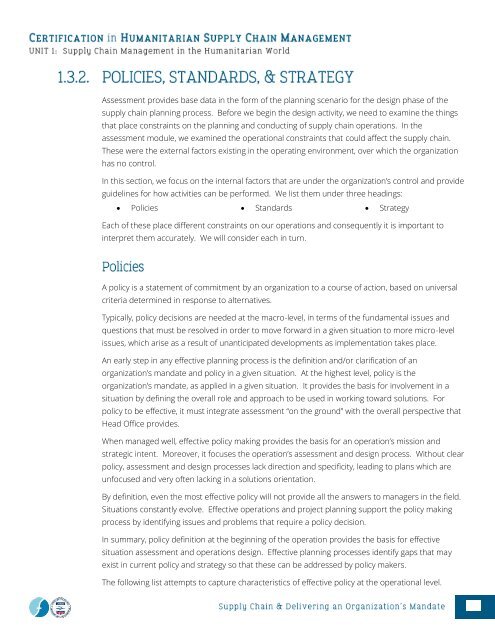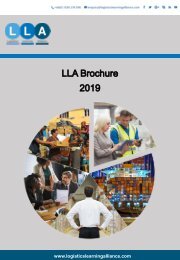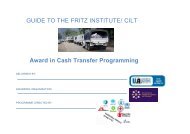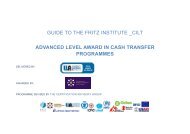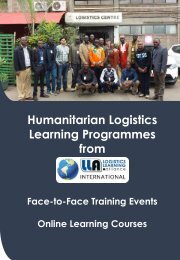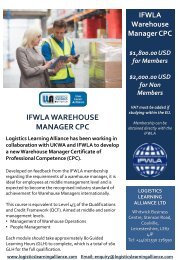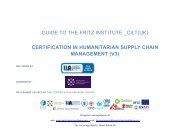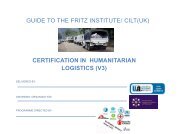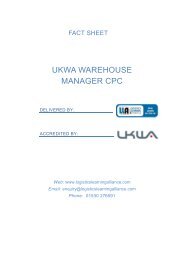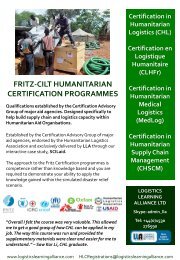CHSCM 3.0 - Unit 1 - SCM in the Humanitarian World
Learning Materials for Unit 1 of the Certification in Humanitarian Supply Chain Management (CHSCM).
Learning Materials for Unit 1 of the Certification in Humanitarian Supply Chain Management (CHSCM).
Create successful ePaper yourself
Turn your PDF publications into a flip-book with our unique Google optimized e-Paper software.
Assessment provides base data <strong>in</strong> <strong>the</strong> form of <strong>the</strong> plann<strong>in</strong>g scenario for <strong>the</strong> design phase of <strong>the</strong><br />
supply cha<strong>in</strong> plann<strong>in</strong>g process. Before we beg<strong>in</strong> <strong>the</strong> design activity, we need to exam<strong>in</strong>e <strong>the</strong> th<strong>in</strong>gs<br />
that place constra<strong>in</strong>ts on <strong>the</strong> plann<strong>in</strong>g and conduct<strong>in</strong>g of supply cha<strong>in</strong> operations. In <strong>the</strong><br />
assessment module, we exam<strong>in</strong>ed <strong>the</strong> operational constra<strong>in</strong>ts that could affect <strong>the</strong> supply cha<strong>in</strong>.<br />
These were <strong>the</strong> external factors exist<strong>in</strong>g <strong>in</strong> <strong>the</strong> operat<strong>in</strong>g environment, over which <strong>the</strong> organization<br />
has no control.<br />
In this section, we focus on <strong>the</strong> <strong>in</strong>ternal factors that are under <strong>the</strong> organization’s control and provide<br />
guidel<strong>in</strong>es for how activities can be performed. We list <strong>the</strong>m under three head<strong>in</strong>gs:<br />
• Policies • Standards • Strategy<br />
Each of <strong>the</strong>se place different constra<strong>in</strong>ts on our operations and consequently it is important to<br />
<strong>in</strong>terpret <strong>the</strong>m accurately. We will consider each <strong>in</strong> turn.<br />
A policy is a statement of commitment by an organization to a course of action, based on universal<br />
criteria determ<strong>in</strong>ed <strong>in</strong> response to alternatives.<br />
Typically, policy decisions are needed at <strong>the</strong> macro-level, <strong>in</strong> terms of <strong>the</strong> fundamental issues and<br />
questions that must be resolved <strong>in</strong> order to move forward <strong>in</strong> a given situation to more micro-level<br />
issues, which arise as a result of unanticipated developments as implementation takes place.<br />
An early step <strong>in</strong> any effective plann<strong>in</strong>g process is <strong>the</strong> def<strong>in</strong>ition and/or clarification of an<br />
organization’s mandate and policy <strong>in</strong> a given situation. At <strong>the</strong> highest level, policy is <strong>the</strong><br />
organization’s mandate, as applied <strong>in</strong> a given situation. It provides <strong>the</strong> basis for <strong>in</strong>volvement <strong>in</strong> a<br />
situation by def<strong>in</strong><strong>in</strong>g <strong>the</strong> overall role and approach to be used <strong>in</strong> work<strong>in</strong>g toward solutions. For<br />
policy to be effective, it must <strong>in</strong>tegrate assessment “on <strong>the</strong> ground” with <strong>the</strong> overall perspective that<br />
Head Office provides.<br />
When managed well, effective policy mak<strong>in</strong>g provides <strong>the</strong> basis for an operation’s mission and<br />
strategic <strong>in</strong>tent. Moreover, it focuses <strong>the</strong> operation’s assessment and design process. Without clear<br />
policy, assessment and design processes lack direction and specificity, lead<strong>in</strong>g to plans which are<br />
unfocused and very often lack<strong>in</strong>g <strong>in</strong> a solutions orientation.<br />
By def<strong>in</strong>ition, even <strong>the</strong> most effective policy will not provide all <strong>the</strong> answers to managers <strong>in</strong> <strong>the</strong> field.<br />
Situations constantly evolve. Effective operations and project plann<strong>in</strong>g support <strong>the</strong> policy mak<strong>in</strong>g<br />
process by identify<strong>in</strong>g issues and problems that require a policy decision.<br />
In summary, policy def<strong>in</strong>ition at <strong>the</strong> beg<strong>in</strong>n<strong>in</strong>g of <strong>the</strong> operation provides <strong>the</strong> basis for effective<br />
situation assessment and operations design. Effective plann<strong>in</strong>g processes identify gaps that may<br />
exist <strong>in</strong> current policy and strategy so that <strong>the</strong>se can be addressed by policy makers.<br />
The follow<strong>in</strong>g list attempts to capture characteristics of effective policy at <strong>the</strong> operational level.


